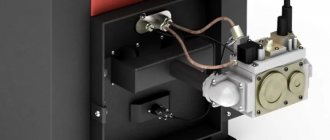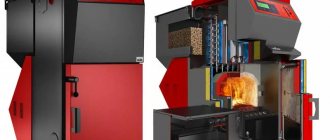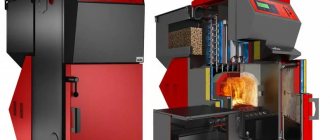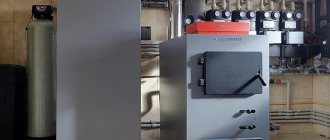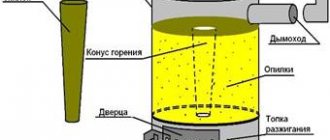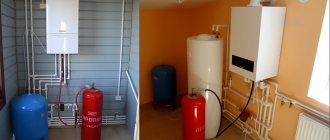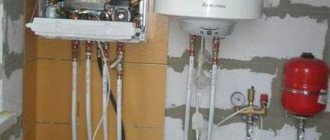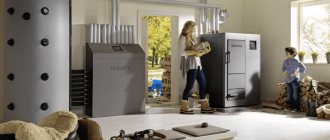The supply of vegetables from distant southern countries in winter provided the shelves with tomatoes, cucumbers, herbs, eggplants and other exotic agricultural products. The first euphoria from such abundance did not last long: buyers quickly realized that for the beautiful appearance of vegetables they had to pay a high price - their health.
Agricultural chemistry and genetic modifications make it possible to produce products that can withstand long-term transportation and long-term storage, reaching the shelves in perfect condition. More and more buyers are consciously abandoning overseas products in favor of greenhouse vegetables and fruits.
Boiler for heating a greenhouse
The greenhouse industry in our country is actively reviving , powerful complexes and numerous private farms are appearing that supply quality products to our tables.
The specific climate of the country forces us
to take the heating of greenhouses and greenhouses seriously a soil and air heating system must be equipped to maintain optimal temperatures. For this, it is worth choosing an economical boiler with high efficiency, which will minimize the cost of growing agricultural products in the winter. Don’t forget about modern technologies, such as gsm modules , which will allow you to control the operation of heating equipment online using a smartphone .
Homemade long-burning wood stoves: diagram and principle of operation
If the air supply is free and the draft is strong, dry firewood will burn very quickly.
If, with a full load of firewood, the combustion is transformed into smoldering by controlling the air supply, the heat release will drag on for hours or even days.
Here is the design of a simple but quite effective wood-burning stove, oriented towards long-term combustion, which repeats the design of the Stropuva boiler. This stove is popularly called “bubafonya” (after the name of the person who first posted the stove diagram on the Internet).
Diagram of a homemade long-burning stove.
Making such a stove is no more difficult than a potbelly stove, which is more familiar to the general public.
However, the combustion principle and design of such a furnace are completely non-standard. Combustion does not proceed from the bottom up, as in ordinary stoves, but, starting from the upper layers, goes down while the wood burns out.
What kind of boiler is needed for a greenhouse?
The classic water heating system is perfect for a greenhouse. It allows you to simultaneously heat the soil and air. To do this, pipes are laid in the ground, and heating radiators are installed outside. The specificity of the operation of this system is the large difference in coolant temperature at the inlet and outlet. After circulation in the system, the water can cool down to 45-50 degrees! Not all heating equipment can cope with such a difference; the most correct solution would be to install a condensing gas boiler. This technique has the following advantages :
- Low fuel cost;
- High equipment efficiency;
- Use of steam energy;
- Compact dimensions;
- Simple controls.
A condition for efficient operation of condensing gas boilers is a low return temperature. Steam condensation occurs at 50ºС and according to this indicator, the greenhouse water heating system fully complies with the requirements of equipment manufacturers. Under such conditions, efficiency reaches 107-109% , which ensures economical heating of farm greenhouses.
High technologies do not always contribute to high quality greenhouse heating. Long-burning solid fuel boilers and pyrolysis models are popular among fans of autonomous heating due to the availability of fuel and its environmental friendliness. It is not recommended to use this technique for heating a greenhouse, since the low temperature of the coolant in the return will cause condensation to form on the internal walls of the boiler and the heat exchanger. When mixed with combustion products, aggressive solutions are formed that destroy the walls of expensive equipment.
In the absence of gas heating, the best choice would be a classic solid fuel boiler . He will cope with the task perfectly, but will require increased attention.
If you have already purchased a pyrolysis boiler or a solid fuel long-burning model, then you will need to consider a system for heating the return to a temperature above 50ºС .
Types of stoves + comparison of fuel options
The design features of stoves depend on the dimensions of the room.
Devices differ according to the dominant criteria for the thermal effect they provide, which include:
- infrared radiation;
- heat transfer;
- convection.
In the oven it is customary to distinguish:
- fuel combustion chamber;
- air flow channels;
- convection shirt;
- additional components.
The following can be used as fuel:
- electricity;
- wood shavings (pressed sawdust);
- peat;
- coal;
- firewood;
- oil-based fuels.
Firewood is affordable. They are a slow burning fuel option.
Coal has a high calorie content. However, its use is limited due to the presence of large amounts of waste, the formation of potentially hazardous substances during use, and the ability to spontaneously combust.
The use of sawdust is justified from the point of view of low cost, environmental friendliness, rapid combustion, minimal smoke and high efficiency. The principle of use is based on their slow smoldering, due to which the greenhouse is heated for a long time.
Burning waste oil for heating is attractive from the point of view of its low cost, but is limited by the toxicity of the compounds formed during its combustion.
The use of electricity is limited by its high cost. In this regard, the spread of electric furnaces is limited.
Where to install the heating boiler?
For large greenhouses, you can build a separate boiler room ; in medium-sized greenhouses, it is better to install heating equipment directly at the entrance to the room . Is it necessary to fence the boiler? This is not necessary, especially in the case of using gas heating equipment. If preference is given to a solid fuel boiler, then you should make sure that there is a supply of dry fuel next to the boiler. If the air humidity in the greenhouse is high, it is worth making a separate room for storing fuel.
Fuel
Fuel is one of the most important issues when equipping a greenhouse with a solid fuel boiler. The main “suppliers” of heat are:
Firewood
The standard requirement for firewood is that it must be dry. Some direct combustion boilers can use raw wood as fuel, but this will reduce the efficiency of the unit. This, in turn, increases the amount of fuel burned.
Attention! For all types of boilers, it is necessary to use firewood from birch, aspen and other species that do not contain resin . During the combustion of coniferous wood, resin particles settle in the chamber and chimney.
How to choose a boiler for greenhouses: advice from experienced farmers
A boiler for greenhouses is the equipment that will allow you to get a good harvest even in severe frosts. Everyone knows how much vegetables cost in winter, so bringing your own vegetables during this period is a very profitable solution. But every vegetable grower who decides to start heating a greenhouse may face the difficulty of choosing a boiler, because there are several varieties on the market. Which one should you choose for this or that site? Or maybe it would be easier and cheaper to make it yourself from scrap materials?
Internal thermal insulation
To make heating more efficient and cheaper, you need to pay attention to thermal insulation.
The base can be sheathed with a suitable material - penoplex or polystyrene foam. Then polycarbonate is mounted on top, which is covered with foil-isolon or simply foil.
Decorating walls in a greenhouse with foil
The frame part can be thermally insulated using double glazing. It would be optimal to use polycarbonate. The inside can be additionally covered with bubble wrap.
Source of the article: https://mrdachnik.com/proekty-otopleniya-teplicy
Boiler options for greenhouses
At the moment, the following boilers for greenhouses are widely used:
- wood;
- combined (wood-coal);
- pellet;
- gas;
- electric.
Conventionally, they are classified into two more subspecies. Solid fuel boilers are the first three types above. Long-burning boilers are included in a separate category, since the principle of their operation is not based on the combustion of materials, but on their smoldering, for which a system of controlled oxygen (air) supply is used. They are the most effective and economical, but are quite expensive.
The simplest heating boilers for greenhouses are gas and electric. However, it is impossible to call them economical and profitable in the current situation. Gas and electricity are already too expensive for heating, and further price increases are expected in the future. Therefore, such boilers are used only for emergencies, when other heating options are simply unavailable for some reason.
You can cook a wood-burning boiler yourself, but it will turn out to be a banal potbelly stove. Its advantages are low cost and efficiency, but its disadvantages are the inability to regulate the temperature, the need to constantly add fuel (wood or coal), as well as uneven heating of the greenhouse area. Their use will be justified only if we are talking about a polycarbonate or glass greenhouse with steam heating (or where the pipes are laid in the ground at a depth of about 50 centimeters). And such a boiler for heating a greenhouse is suitable only for small areas. If the greenhouse occupies more than 50 square meters, then several “bourgeois” will be required. Keeping track of them is extremely difficult and troublesome.
But there is also a very big advantage for wood-burning boilers and long-burning boilers for solid fuel greenhouses. The product of their waste is ash and ash, which are extremely useful “ingredients” for growing any vegetable and fruit crops. And in the case of beets, for example, ashes allow you to get rid of any insect pests and thereby save a considerable amount on the purchase of agrochemicals (pesticides and mineral fertilizers). For a vegetable grower, this is not the least advantage.
Review of furnaces from the manufacturer
Comparative characteristics of popular models of long-burning stoves are given in the table below:
| Model | Fuel | Characteristics | price, rub. | Note |
| Buleryan | Firewood | Convection type. Heat exchange occurs due to infrared radiation, convection and heat transfer. | 8000-25000 | The manufacturing patent belongs to . In Russia, it is produced by Laoterm JSC under the name Breneran. |
| Butakova | The shape resembles a parallelepiped. The principle of operation is similar to the Buleryan type oven. | 10000-35000 | Named after the designer of the product. | |
| Slobozhanka (“super potbelly stove”) | Firewood, cones | Combustion chambers vary depending on the type of air supply. | 8000-12000 | The models are convenient with the ability to connect a water circuit and radiators. |
| Vologda | Firewood | Fuel is added several times a day; Efficiency=80-90%. Flexible hoses are used to supply water. Heating time to 60°C is 35-40 minutes. | 4000-6000 |
Which boiler to choose for a greenhouse
When choosing a boiler for heating greenhouses, you need to take into account both the area of the heated room and your financial capabilities. Ideal - long burning, but they cost an average of 100 thousand rubles. But their consumption is 2 styling for 24 hours. In large greenhouses, they completely pay for themselves in just 1-2 seasons (if the firewood or coal is purchased). In small ones, with an area of about 15-20 square meters, the payback will stretch over almost 10 seasons.
For the latter option, simple solid fuel heating boilers or those that run on gas would be ideal. The efficiency of the system will be significantly higher if it is supplemented with a pump for pumping water through pipes. This, by the way, will ensure uniform heating of the heated room.
An electric boiler, as practice shows, is a pointless waste of money. They are inefficient, use too much electricity, and only increase the temperature at the top of the greenhouse. The volume near the ground remains cold, which leads to freezing of plants.
Combined long-burning boilers are classified as industrial boilers.
They should be purchased only if the greenhouse is over 100 square meters and crops that react extremely sharply to changes in microclimate are grown in it.
These are, for example, bell peppers, strawberries, strawberries, raspberries, eggplants, carrots, potatoes. They cost accordingly - from 200 thousand rubles. But the savings are huge! And boilers of this type also operate on liquid fuel (meaning recycled oil, fuel oil, oil industry waste).
A few words need to be said about the pyrolysis boiler, which is conventionally a derivative of long-burning solid fuel. Its operating principle is based on burning wood gas. It has very high heat transfer, since a flame is supplied through the nozzle as if from an autogen, thereby quickly heating the water tank. The heat can be dissipated into a steam heating system or by a fan through a radiator. Such a boiler is both productive and economical, but it occupies quite a large space (including in height). Not suitable for small greenhouses, as they can burn plants. The landing distance from the boiler is at least 50 centimeters.
Operating principle of greenhouse stoves
The fuel for such furnaces can be the following:
- Coal formed into briquettes.
- Sawdust and seed husks pressed into pellets.
- Peat.
- Household waste.
- Wood.
The latter material is used in most cases. The design features of the boiler allow the wood to burn for a long period, up to 24 hours. The wood stack burns completely, so there is practically no ash left. This is very convenient, since you only need to clean the sawdust stove for a greenhouse once every two weeks.
Of the many positive characteristics, the following attracts attention:
- The stove can be connected to a water circuit and heat the air.
- No connection to power supply or gas system is required for operation.
- The efficiency of a greenhouse stove is about 90 percent.
- Operation of the device is quite simple.
- The device allows you to get some savings.
The fuel burns for a long time due to the ongoing pyrolysis process. A limited amount of air enters the chamber, so the wood does not burn, but smolders in the oven. As a result, a large amount of pyrolysis gases is released, the combustion of which in the additional chamber is accompanied by the release of additional heat. In other words, heat is generated by the combustion of fuel and combustion of gases. This prolongs the process and makes it more efficient. In addition, remember that larger fuels will burn longer. Consequently, the use of large logs rather than chopped firewood will allow you to add fuel once every two days.
Emergency heating boilers
An experienced vegetable grower always has different types of heating boilers at his disposal, since one of them may turn off due to an interruption in gas supply, electricity, or simply break down. So, for emergency situations, electric ones are ideal, where the heating element is heated, and the heat is dissipated by a cooler. But they should be supplemented with an autonomous generator.
The most ordinary wood-burning stove is also an excellent solution for emergency heating of the greenhouse volume. But its construction should be done in advance. Smoke removal can be done in several ways. But we must not forget that vaporous gas is not harmful to plants and reduces thermal conductivity. Thanks to this, the cooling rate of the greenhouse will be significantly reduced.
Every vegetable grower could use a mobile pellet boiler. It is quite easy to transport, but it is useful for burning any solid fuel, including corn cobs. At the same time, heating occurs quickly and evenly. The only drawback is the need to have a chimney, and in strong winds it will blow in from the outside. That is, a large amount of smoke will enter the greenhouse. Plus, pellet boilers are demanding to maintain. They quickly accumulate moisture, which can only be removed mechanically. In any case, this is an excellent option for emergency heating, in which fuel can even be combined (for example, kindling with wood, maintaining temperature with coal or peat).
Myths about long-burning stoves
Recently, marketers have begun to classify a special type of non-volatile heaters, designed for operation in smoldering mode, as this type. Example: stoves “Professor Butakov”, “Buleryan”, etc. Indeed, with a limited air supply through an adjustable throttle, the fuel smolders instead of burning and therefore the unit can work on one load for up to 8 hours.
But the unit has a number of disadvantages:
- fuel is consumed extremely irrationally: when smoldering, it does not burn completely and a significant part of it literally flies down the chimney;
- The heat release power in the smoldering mode is very low (the characteristics indicate the power in the combustion mode);
- The exhaust in smoldering mode is cold, so condensation forms abundantly in the chimney. The latter, due to incomplete combustion of fuel (smoke contains many heavy hydrocarbon radicals), is a toxic cocktail that is even prohibited from being poured into the ground near edible vegetation;
- The unit smokes heavily in smoldering mode.
Marketers call such furnaces pyrolysis, since their design includes a compartment for afterburning gases. This is a reason to call such a unit economical. But this is a fiction: at such temperatures there is practically no pyrolysis.
In general, such stoves are intended for field conditions where there is no power supply: they enable a team, for example, lumberjacks (Buleryan was created for them), to sleep at night without worrying about firewood. In greenhouses, if such stoves are used, it is in combustion mode, like an ordinary potbelly stove.
Boiler for heating a greenhouse: wood, electricity and gas
Now we will look at the options for boilers for heating a greenhouse and see which one to choose. This can be a wood-burning, gas or electric boiler.
Currently, a healthy lifestyle is being massively popularized. A person’s physical condition depends, first of all, on what foods he consumes. Therefore, today more and more people are trying to eat healthy.
As you know, vegetables and fruits that lie on store shelves are stuffed with nitrates and other poisons, so many decide to grow their own food and resort to using greenhouses. In order for plants to grow well, it is necessary to maintain a comfortable temperature in the greenhouse, especially in winter when the air temperature is low.
Moreover, for the normal growth of your vegetation, it is important to heat not only the air, but also the ground. If this is not done, the grown products will simply die. To prevent this from happening, it is worth acquiring a boiler for heating greenhouses. This is the equipment that will act as a source for maintaining the desired temperature in your “winter garden.”
The main factors that influence the choice of heating method for greenhouses are cost and temperature stability. Therefore, it is important to choose a good heating unit.
Boilers for greenhouses are:
- solid fuel;
- gas;
- electric.
Solid fuel boilers
Today, wood heating units are the most common and affordable. This is due to their high productivity and efficiency, because the fuel for them is ordinary firewood, waste from furniture and woodworking industries, wood trimmings, branches cut from trees and even dry garbage.
You can choose among the following types of solid fuel boilers:
- wood (conventional or pyrolysis);
- coal and wood;
- pellet (work on compressed pellets of wood, seeds, straw, and various waste).
Solid fuel boilers for greenhouses have many advantages:
- environmental friendliness;
- cheapness;
- availability;
- safety;
- aesthetics;
- non-explosive.
The efficiency of such boilers is in the range of 75–90%.
Using solid fuel boilers as a method of heating the greenhouse, you can be content with fresh vegetables and fruits all year round.
However, such devices also have some disadvantages:
- To store such devices, you need a “solid” size area.
- It is necessary to prepare fuel in advance.
- They require regular maintenance (cleaning the boiler firebox from ash, adding fuel).
How to make a boiler for a greenhouse with your own hands
If you want to save money and do not want to buy a ready-made unit, you can make a solid fuel boiler for heating a greenhouse with your own hands.
To do this you need to perform a number of actions:
- Get a barrel with a volume of 3 cubic meters.
- Using a drill, drill three holes in it, which will serve for the outlet of the chimney, drain and expansion tank.
- At the next stage, a 5 m high chimney is attached to the barrel. This device will be responsible for removing carbon dioxide from the greenhouse.
- An expansion tank must be attached to the top of the barrel; you can weld it yourself.
- Then you need to lay a heating system throughout the greenhouse; the best and cheapest way is plastic pipes.
- Using a special soldering iron, you need to weld the pipes together.
Plastic does not rust or corrode and is able to remain operational despite temperature changes and high humidity.
Making a greenhouse boiler with your own hands
The first step towards self-installation of heating equipment in order to create a heated greenhouse in a personal household should be a detailed drawing of the planned heating installation. The required power is also calculated based on the area and volume of the room, type of boiler, type of fuel, operating time, etc. After a painstaking process of theoretical pre-preparation, one should proceed to the main stages of creating a boiler.
You will be interested to know how to insulate a greenhouse for the winter with your own hands.
Materials and tools
For a simple solid fuel boiler model you will need:
- A metal barrel with holes or an old gas cylinder, sawn in half.
- Water circuit or coil.
- Hinges, metal handles, matching latches, etc.
- Welding machine.
- Cutting tools.
Construction and connection
The most common model of a homemade boiler looks like this:
- The cylinder (barrel) is placed in a metal oven.
- A chimney pipe is welded to the resulting structure, through which gases will be discharged from the greenhouse premises to the outside.
- The last stage is welding pipes (plastic, metal) together and their further installation.
Video: how to make a solid fuel boiler with your own hands
Gas devices
Gas boilers for greenhouses are a good option. They ensure that the greenhouse operates smoothly and is heated at a level suitable for the vegetation. The automation of the boiler ensures its autonomous operation, while human participation in this case is limited.
Using gas heating, you can heat the greenhouse in one of the following ways: air, water, infrared.
Infrared gas heater for greenhouse
Most often, infrared gas heaters are installed on the roof. This is due to the fact that gas infrared heating of a greenhouse in winter has one important advantage: the soil is heated first, and only after it the air.
The disadvantage of such heating is the need to install ventilation to remove combustion products.
The second option is to heat the greenhouse with a gas boiler combined with a water system.
Gas boiler for greenhouse
To put this heating method into effect, it is necessary to install smooth pipes with a diameter of no more than 40 mm over the entire area. They need to be laid along each bed 20-30 cm above ground level. The following types of wiring are allowed:
- The supply line is along one wall, the return line is near the other. They are connected to each other by transverse pipes running between the beds.
- The supply and return lines are laid along one wall. Each heating pipe runs along one bed and returns past another.
- The pipe is laid in a snake pattern over the entire area of the greenhouse, forming a single heating circuit.
Shut-off valves must be installed on each branch so that it is possible to turn off the circuit in the event that there is no vegetation in the greenhouse.
In a greenhouse heating system using a gas boiler, the main advantages can be noted:
- autonomous operation of the device;
- ease and speed of boiler maintenance;
- high efficiency.
- It is difficult to supply gas to the greenhouse: you need to call a special service.
- High cost of gas tariffs, especially in the summer.
Electric boilers
Electric boilers are easy to use and accessible wherever power lines are installed. But if you want to purchase an electric boiler to heat the greenhouse, then you should understand that such equipment is quite expensive, and its use is not always appropriate or justified. In addition, now there are often blackouts, and during such a period your vegetation may simply die.
However, such heating, calculated per unit of heat, is the most expensive. In addition, to connect an electric boiler, a separate line is required, and often not 220 V, but 380 V, and wiring such a line is a complex, time-consuming and expensive process, and besides, this option is not possible everywhere due to the lack of technical capabilities.
The advantages and disadvantages of an electric boiler for greenhouses are as follows.
| Advantages | Flaws |
| Low price of equipment. | The need for a permanent connection to the power grid. |
| Availability. Can be purchased at any large hardware store. | High energy costs. On average, electricity bills when using such a heat source increase by 10-20%. |
| Convenient control system, so there are no difficulties with operation. | |
| No combustion products, no need to install a chimney. | |
| Minimal maintenance. The electric heating element does not need to be cleaned of soot or dirt, as, for example, in solid fuel boilers. Maintenance is required approximately every 2-3 years. | |
| Convenient to locate, do not take up much space, most devices are wall mounted. |
A greenhouse is a great opportunity to please yourself and your loved ones with fresh and natural vegetables and herbs not only in the summer, but also in the winter. In order to successfully grow vegetable crops and ultimately harvest a good harvest, you need to ensure a good temperature in the greenhouse. Helpers in this matter are boilers for heating greenhouses. Each heating method has pros and cons, so in each individual case one or another option may be the most optimal.
Based on your capabilities, you can choose the appropriate option and ensure the fruitful growth of your plants.
What to consider when choosing a heating system?
When choosing a heating system, you need to pay attention to the overall dimensions of the room and its type, because For different materials, the required heating intensity will also vary. For example, polyethylene is characterized by high heat loss, so a greenhouse made of this material will require more intense heating compared to a greenhouse made of polycarbonate.
Polycarbonate greenhouse
When arranging heating for a greenhouse, take into account the total costs of installing the system and its maintenance. Some heating options require significant financial investments, and their use in small greenhouses will not be practical. Others are simple and inexpensive to install, but consume a lot of fuel during operation.
Greenhouse heating
Otherwise, the owner must decide for himself how beneficial the use of one or another heating option will be specifically for his situation. The main thing is that the system ensures uniform distribution of heat throughout the room, does not dry out the air and creates optimal conditions for the development of grown crops.
Boilers for heating greenhouses
Today, many people prefer to eat vegetables and fruits grown in their own garden plot. Everyone wants to see fresh food on their table all year round. For some, it is proper nutrition, and for others, it is a way to earn money.
To achieve the possibility of growing various crops at any time of the year, regardless of weather conditions, it is necessary to properly equip the heating system in the greenhouse.
You can entrust the installation of the greenhouse heating system to professionals, but if you have the desire and some knowledge, it is better to do it yourself.
Types of heating
You can heat a greenhouse in various ways and each of them has its pros and cons.
To learn about the applications and types of induction heating boilers, click here.
You can read about the design, principle of operation and leading manufacturers of double-circuit electric boilers at the link -
Also read about the types and features of operation of solid fuel and liquid fuel boilers.
Air heating
The simplest and cheapest type of air heating has the following structure: a three-meter steel pipe is brought into the greenhouse at one end, while a fire is lit under the other. As soon as the pipe begins to heat up, hot air enters the greenhouse, thereby heating it.
This type of air heating is not particularly convenient due to the need to constantly keep the fire burning, so it is used only in emergency cases. If instead of a fire there is a modern heating boiler, then the process of heating the greenhouse will become much easier.
With the help of a boiler, the greenhouse heats up quickly and efficiently, but there is also a disadvantage - drying out the air in the heated room.
The air in the boiler washes the firebox and heats up, after which it is distributed throughout the greenhouse using air ducts. The lack of humidity can be compensated for by placing buckets of water inside the greenhouse or using modern air humidifiers.
The combustion products of a heating boiler have a high temperature, which can be used to heat the soil (through pipes).
Water heating
Heating greenhouses using liquid coolant is the most common. The main elements of such a heating system are: a boiler, heating circuits (radiators, coils), a circulation pump, pipelines, fittings and protective elements.
To uniformly heat the greenhouse, it is necessary to install several heating circuits at different height levels and an underground “warm floor” coil. Regulating the air temperature in the greenhouse can be entrusted to automatic sensor-relays. The temperature will be regulated by decreasing or increasing the intensity of coolant movement.
If you install your own circulation pump and temperature relay for each heating circuit, you can set an individual operating mode for each circuit.
If we compare water and air heating systems, then:
- An air heating system warms up a room faster than water heating.
- Air heating has a simple design and does not require a lot of additional equipment, unlike water heating.
- Water heating has a labor-intensive installation process and requires the installation of additional equipment, but is more efficient than air heating.
Boiler selection
The choice of boiler for heating a greenhouse directly depends on the preferred type of fuel, the size of the greenhouse and the outside air.
Depending on the type of fuel, the units are:
- Solid fuels burn coal, peat, and firewood. They come in regular, long-burning and gas-generating types.
- Liquid fuel boilers burn diesel fuel or kerosene.
- Combination boilers can operate on different types of fuel.
- Gas boilers operate on natural gas or a propane-butane mixture.
- Electric boilers do not burn fuel. The coolant is heated using heating elements.
The power of the unit is selected in accordance with the calculation of heat losses of the greenhouse and its dimensions.
Wood-fired air-heating boilers
Air heating units that burn wood can quickly heat the air in a greenhouse, while installing the boiler is not a labor-intensive process.
The operating principle of an air-heating boiler is based on creating natural air circulation in the greenhouse: the air heated in the boiler is sent into the greenhouse, thereby displacing cold air back into the boiler and this cycle is constantly repeated.
Air-heating pyrolysis (gas generator) boilers are a regular solid fuel boiler, but with an additional firebox. It is needed to burn flammable gas, which is released when burning wood with oxygen deficiency.
The furnaces of the pyrolysis boiler are located one above the other. Firewood is loaded into the lower one and ignition is carried out. During the combustion process, pyrolysis gas is released, which accumulates in the upper firebox and ignites there, releasing heat.
Advantages of pyrolysis boilers:
- High coefficient of efficiency (efficiency).
- Relatively cheap compared to analogues.
- Easy to install.
- Quick heating of the room.
- Long service life (from 20 years).
Disadvantages of pyrolysis boilers:
- The need for fuel procurement and storage.
- The need to constantly remove ash and clean the chimney.
- When the boiler is operating, a burning smell may be released.
Read about household floor-standing double-circuit gas heating boilers in the article.
You can read about automatic long-burning boilers using wood materials in the following link:
Infrared heating
In addition to its direct purpose, infrared heating of a greenhouse also favorably promotes plant growth and does not harm human health.
The air is heated using a special infrared thermal film, which is completely safe, easy to install and connect. The heating of the film is controlled by an automatic system and reaches 20-500C.
Principle of operation
The infrared film has instructions for its installation. This process does not require special skills; you just need to deepen it into the ground to the specified depth. Next, you need to connect to the electrical network. You need to set the desired temperature and the greenhouse will begin heating automatically.
When installing several temperature controllers, it becomes possible to configure an individual mode for each bed.
The efficiency of infrared film is 95%. In this case, all the heat is used gradually and for its intended purpose - the soil is heated, and then the air is heated.
Electricity consumption
The average electricity consumption is 60 Wh per 1 m2 of infrared film. The maximum electricity consumption is 240 W/h per 1 m2. Such consumption occurs only when the film is heated from a cold state. Further heating operation is more economical - the lower the maintained temperature, the lower the energy consumption.
Heating a greenhouse can be arranged in various ways; the choice of equipment is very wide, so choosing the right one will not be difficult.
Homemade “bubafonya” with long burning
Using a grinder, cut off the weld seam from the top end of the barrel and smooth out the sharp edges.
The result is a cylinder and a lid with a finished flange. Using a hammer or sledgehammer, bend the edges of the cylinder inward. And bend the flange of the lid outward. Turn the cap over and place it on the cylinder. The lid will sit securely in place without slipping. Using a chisel, cut a hole for the blower pipe in the center of the lid (so that it fits freely into the hole, it is enough to use a diameter of 102 mm).
Assembly diagram for “bubafoni”.
The hole for the plug on the lid can be sealed tightly, but it is better to leave it: by looking inside you can regulate the combustion process.
Then, at the top of the barrel, a place is marked for attaching a piece of the chimney pipe.
The intended hole is cut out and a piece of chimney pipe 20-25 cm long and 150 mm in diameter is welded. You can install a shut-off valve directly inside the pipe. The stove body is ready.
Next in line is the air supply device. For greater rigidity, the edges of the pancake are bent (so that the pancake does not curl from the heat). A hole is cut in the center of the pancake for the blower pipe, and it is welded. If a lid from another barrel is used for the pancake, then the hole for the cork is sealed tightly: during combustion, gases will pass only around the circumference of the pancake. Channels or corners are welded to the pancake from the bottom side. The air supply device is also ready.
It will be inserted inside the cylinder. An adjustment valve of the same diameter as the pipe is placed at the top of the blower pipe. A threaded pin is welded vertically to the inner wall of the pipe; a hole is drilled at the edge of the damper for this pin, ensuring that the damper mounted on the pin closes the pipe exactly.
After installing the damper, tighten it with the wing nut. By loosening the nut, moving the damper towards the edge of the pipe and tightening the nut back, it will be possible to regulate the flow of air into the firebox.
Place the lid on top and the entire stove is ready.
All that remains is to install the chimney pipe. Its diameter must be less than 150 mm, otherwise combustion products will not be completely removed. For good traction, it is better to have a pipe 5 m long. Install it near the stove, preferably on legs. Weld the bottom of the pipe hermetically.
Connect the stove end-to-end to the elbow, which is welded to the chimney pipe, tighten it with a clamp, placing fiberglass under it for tightness. To drain the condensate that collects in the pipe, a ball valve is welded under the pipe elbow (a rod can be used to clear the blockage).
This tap is absolutely necessary, since freezing of the condensate can cause the weld to rupture. Condensation, in addition, can flow into the stove, and through leaks in the connecting clamp - out.
Now you can now heat the “bubafonya” stove. After removing the cover, pull out the air supply device. Place the firewood - the height should not exceed the height of the lower edge of the chimney elbow. If you place firewood vertically, more will go in. You can choose large logs, up to 20 cm in diameter - they will burn without any problems.
A top layer of finely chopped wood chips is formed. Place a rag or paper on top and pour a little kerosene on it. Now the firewood is covered with a pancake of the air supply device, and the stove lid is strung on top. When opening the air damper, throw a piece of lit paper or rag inside the air supply pipe (matches quickly go out due to strong draft).
When the firewood flares up with a characteristic crackling sound, the blower damper is completely closed. Bubafonya can work in this mode without any supervision for days.
This long-burning wood stove produces little ash due to the fact that the wood burns almost completely. The ashes may not be removed for a long time.
As you can see, it is quite possible to construct “Bubafonya” stoves with your own hands. Many craftsmen make them not only from barrels, but also from old gas cylinders and large fire extinguishers. The main requirement for a future furnace is strong steel walls.
We make boilers for greenhouses
In recent years, an increasing number of people are thinking about a healthy diet without nitrates and other poisons present in purchased vegetables, fruits, herbs. And many decide to grow their own food using greenhouses. For some, this becomes a profitable business that brings pleasure and tangible income.
Boilers for greenhouses
But it’s not enough to install a greenhouse; you also need to heat it on cool days to get early vegetables. The heating issue can be solved in different ways. How to heat a greenhouse efficiently and inexpensively? What fuel should I use to heat it? Is it possible to do this yourself? Answers to these pressing questions can be found in this article.
Features of heating greenhouse premises
The main factor in choosing a heating method for greenhouses is the price of maintaining the temperature. After all, most greenhouses have enormous heat loss. Ideally, for good plant growing, the greenhouse should be built from metal profiles and plastic, with hermetically sealed double-glazed windows.
But most vegetable growers and farmers cannot afford this method of construction, so most domestic greenhouses are covered with polyethylene or polycarbonate. These materials are transparent to sunlight, but also release a large percentage of heat into the surrounding space, so heating the room must be well thought out and powerful.
Boilers for greenhouses
After building the greenhouse, it is necessary to begin creating a heating system, the central element of which will be the boiler. The most commonly used:
- Electric ones are simple, easy to use and available wherever power lines are installed. But using such a boiler to heat a greenhouse will cost a pretty penny, and now rolling or emergency blackouts are common, and then young plants can die from the cold.
- Gas - a stable supply of natural gas ensures good heating of the room, but the price of this energy resource is also quite high. Although many farmers use gas boilers to heat greenhouses because they are easy and quick to maintain, you only need to pipe gas into the greenhouse once and connect the boiler - and the problems are solved. Regulating and maintaining the desired temperature is easy and simple, and the efficiency of gas heating has been proven for years. Often, greenhouses are heated with gas by those whose premises are located next to a gasified house.
Gas boilers are available; a regular home floor-mounted version of suitable power is suitable for a greenhouse. Combustion products do not need to be removed outside the greenhouse, because all carbon dioxide is processed by plants during photosynthesis. And automation allows a person not to think about maintaining the temperature in the room.
But there are also disadvantages:
- Supplying gas to a greenhouse is quite complicated and requires the participation of special services, which will result in significant financial costs.
- During peak hours, the gas pressure may decrease, which is why the boiler sometimes goes out, and this is dangerous for the normal development of plants.
- In the winter months, gas tariffs increase with excess consumption, and to save money it is necessary to reduce the temperature in the greenhouse, which can negatively affect the growth of vegetables and fruits.
- Solid fuel boilers, or pyrolysis boilers as they are also called, are used very widely, including in heating greenhouses. This is explained by their high productivity and efficiency, because for heating you can use firewood, wooden trimmings, waste from furniture factories, branches cut from the garden plot and even dry garbage. These types of fuel are cheap and available, which makes such boilers attractive to greenhouse owners, since savings on heating allow plants to be grown much cheaper. After all, when heating with electric boilers, you can get golden vegetables and herbs; the cost of growing them significantly exceeds the price of selling them. And solid fuel boilers are not only economical, but also easy to use. Most modern models are fully automated and require fuel only twice a day.
Heating of greenhouses with solid fuel boilers
Heating greenhouses with solid fuel boilers makes it possible to grow plants all year round, creating your own profitable and stable business.
Solid fuel boilers are divided into:
- wood-burning (regular or pyrolysis);
- coal-wood;
- pellet (work on compressed pellets of wood, seeds, straw, and various waste).
Advantages of solid fuel boilers:
- environmentally friendly;
- cheap;
- aesthetic;
- available;
- safe;
- after their work, ash remains, which is an excellent fertilizer and means of pest control.
- large areas are required for fuel storage;
- requires preliminary fuel procurement;
- regular maintenance (filling fuel, cleaning ash).
Specifics of maintaining temperature
Heat leaves the greenhouse through the ceiling and walls, as well as as a result of fresh air entering through the ventilation holes. To compensate for such heat loss, it is necessary to organize an efficient heating system. Before starting any installation work, experts recommend insulating the structure. It is important to minimize the entry of outside air.
Important attention should be paid not only to the material with which the frame of the structure is sheathed, but also to the features of its installation. The greenhouse should fit as closely as possible to the ground. The best option would be to build a foundation that is laid at a shallow depth. It is additionally insulated. At the same time, the strength of the base is important, which ensures reliable installation of the structure.
The depth of the foundation should be 30 cm. Such conditions are imposed even on structures that are erected in regions with harsh climatic conditions. Through the soil, which is located inside the greenhouse, heat escapes in very small quantities. As for heat loss around the perimeter, it can be reduced with the help of ordinary snow, which is a natural seasonal insulation.
Solid fuel boilers are ideal for greenhouses
To ensure normal plant growth, it is necessary to establish optimal temperature conditions, as well as ventilation of the structure. If all systems are properly organized, the ground temperature will be the same as in the summer.
The depth of soil freezing depends on the geographical features of the region. To overcome any natural limitations, it is necessary to create optimal conditions for plant growth. Thermal energy can be directed both into the surrounding air and into the soil itself. In the latter case, the optimal condition is to install an underground pipeline.
Heating a greenhouse entails considerable material costs, which depend on the following factors:
- The area of the walls, as well as the roof of the structure. The smaller the surfaces, the lower the heat loss. In this regard, experts recommend using semicircular or rectangular frames to build a greenhouse.
- Thermal conductivity of the material. If the coefficient is low, the material will retain heat well.
- Difference between outside and inside temperatures. With a significant difference in temperature conditions, heat loss is significantly high.
- The presence of cracks and places where the finishing material does not adhere tightly to the greenhouse frame. Through them, cold air will flow into the structure, which will lead to a decrease in temperature.
There is a large selection of greenhouses on the modern market. Therefore, there is no unified system for organizing the heating of a building. In each case, it is necessary to develop an individual project.
The unit can be built by hand or purchased ready-made
